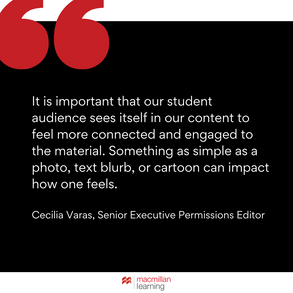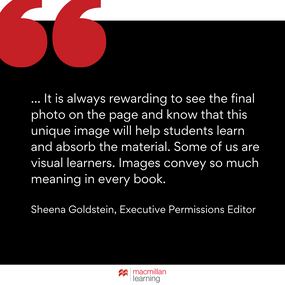-
About
Our Story
back- Our Mission
- Our Leadershio
- Accessibility
- Careers
- Diversity, Equity, Inclusion
- Learning Science
- Sustainability
Our Solutions
back
-
Community
Community
back- Newsroom
- Webinars on Demand
- Digital Community
- The Institute at Macmillan Learning
- English Community
- Psychology Community
- History Community
- Communication Community
- College Success Community
- Economics Community
- Institutional Solutions Community
- Nutrition Community
- Lab Solutions Community
- STEM Community
- Newsroom
- Macmillan Community
- :
- Newsroom
- :
- Learning Stories Blog
- :
- How One Team Helps Visualize Diversity in Course ...
How One Team Helps Visualize Diversity in Course Materials
- Subscribe to RSS Feed
- Bookmark
- Subscribe
- Printer Friendly Page
- Report Inappropriate Content
At Macmillan Learning we envision a world in which every learner succeeds. We recognize that to do just that, it’s critical that students recognize themselves in our course materials. Each and every team within the company has an important role to play in achieving that goal.
When thinking about the teams that create educational titles, we may first consider those who write the materials. It’s easy to recognize the strong impact they have on what information is shared in a textbook. But there’s more to it than just that. There are teams that have the important task of selling or marketing the materials, which helps make the materials available to the students that need them.
But there’s one team that’s also critical to making diverse and inclusive course materials -- and that’s the team that manages our rights and permissions. This team enables Macmillan Learning to use audio, video, photo/images, and text assets in each of our titles. This is no small task when each title can have hundreds, if not thousands, of media assets.
Working in collaboration with Editorial teams, the Permissions team helps decide which images and media to include, ensuring that they add value to the learning experience while also representing and reflecting the many different students and instructors who may use the materials. The team also checks the content throughout the production process to ensure that there’s no misrepresentation. This is true both when there’s a new title we plan to publish as well as when we’re updating an already existing title for a new edition. For many years, educational materials did not reflect the diverse population that used them which is why this team has been redoubling their efforts to ensure this very important work is addressed.
Creating representative and diverse textbooks

According to Cecilia Varas, Senior Executive Permissions Editor, “Representation matters when teaching students from all over the world. It is important that our student audience sees itself in our content to feel more connected and engaged to the material. Something as simple as a photo, text blurb, or cartoon can impact how one feels.”
To that end, the Rights & Permissions team finds content from a variety of sources. They seek out partnerships with organizations that specialize in diverse materials as well as collections from existing partners that have committed to offering inclusive content. “It’s fun to research new DEI artists and photographers. Sometimes we have the opportunity to work with incredible photographers, illustrators and artists,” said Robin Fadool, Executive Permissions Editor. She cites her work with artist Cynthia Fisher on For All Practical Purposes and photographer Lois Greenfield to get a licensed photo of Parsons Dance for the cover of Schacter Psychology 6th edition.
What the rights and permissions Team does
When the team gets "rights and permissions” to use copyrighted material, that means that they’re obtaining the authorization and consent from the copyright holder to use their work in a specific manner. It’s a process that’s not always linear, as sometimes the owner of the copyright is deceased, or the copyright for materials has changed hands. The diverse content varies greatly from historical -- like speeches from Martin Luther King Jr. -- to more contemporary works, like a photo of a painting of Michelle Obama for use on a textbook cover.
Another important, but challenging, part of the work is ensuring the copyrighted works are being used as intended, and that involves a detailed accounting of them. “So much of our work is tracking. Tracking assets and the rights associated with them. We try to keep it simple by requesting broad rights and working with preferred vendors but when we license for video or text, the tracking of restrictions needs to be accurate. Data entry standards are very important in our group,” said Christine Buese, Executive Permissions Manager.

And, surprisingly, the opposite is also true -- the team also receives permission requests to use our material in other publications. According to Alexis Gargin, Permissions Editor, these can range from journal articles and textbooks to more unique usages such as a TV classroom prop, a whaling museum, and a Swiss hiking trail. If you look closely, you may find Myers/Psychology in Patriot's Day or Henretta/America's History for the AP Course 2020 in The Republic of Sarah, for example.
In addition to being researchers and trackers, the team is also skilled in negotiations. While there are often standardized licensing agreements with the company’s preferred vendors, particularly for common types of content like stock photos, that’s not always the case. It's common for negotiations to cover what the assets will be used for, the period of time in which they will be used, as well as payment terms and any limitations.
Diversity and inclusion in action
Because the educational publishing industry serves and informs students and instructors from a variety of backgrounds, its goal is to offer diverse materials that are backed by research and pedagogical insight. But in order to use diverse materials, those materials first need to exist. Oftentimes, this means going back to the drawing board (literally and figuratively speaking) to create representative content. This is done with both the company’s preferred vendors alongside new ones. And it can be done in big and little ways -- from re-imagining the entire cover of a textbook to changing captions that accompany new images. Their strategies are informed by a set of guidelines created by the company’s editorial teams.
Some of the many guidelines include recommendations like: Include photos and content that showcase a diverse array of humans and human activity; present people in non-stereotypical roles; Consider a full range of diversity categories: race, ethnicity, nationality, gender and gender identity, sexual orientation, age, religion, political affiliation, ability, socioeconomic status, veteran status, family status, and environment; Be aware of your own preferences and biases.
One example of how the team put the concepts from the guidelines in action was by partnering with a preferred vendor, Cartoonstock, to improve the process of revising cartoons and, in turn, make content more inclusive. Goldstein cites working on Jonathan Gruber’s Finance and Public Policy 7th edition on cartoon captions and imagery revisions as an important step for her and the entire team, as it was the first title that she and the Economics editorial team had done revisions on a significant amount of cartoons.
Previously only 23.5% of the cartoons had women represented in its cartoon program for the previous six editions of the book. Now, there are 43% female‐presenting characters and 31% people of color. There are also now two people representing the LGBTQ+ community and one person with a physical disability, where previously those communities were not represented visually in the text. In addition to improving representation, the partnership also taught the team several best practices for future projects on how to best adapt cartoons for DEI.
While some progress is quantitative, like Finance and Public Policy, some progress is done behind the scenes and is more qualitative. Gargin noted, “One of my favorite projects to work on was Developing Lives 2.0 because of all of the diverse photo research. This digital project showed how families are all different and unique and yet we all face the same challenges from selecting which schools to send our children to or even just deciding between a cat or a dog as a pet. The editorial team requested photos that represented how multiple countries and cultures celebrated life milestones from Korean Doljanchi to Apache Sunrise Ceremony.”
Varas cited her recent work with the history title Freedom On My Mind as a highlight. The textbook offers narratives of African American and US History with documents that support the inspiring quest for freedom, the American dream and the countless contributions of African Americans to our collective history. She obtained permission from the Smithsonian/National Portrait Gallery to use an image of Michelle Obama by painter Amy Sherald.
“As editors and researchers, we’re always curious. We always want to make sure that the content is fresh and relevant. The team really cares about our products and what they see when they turn the pages of our books, and are always looking for new material” said Hilary Newman, the team’s leader and Senior Director of Rights and Permissions. “There’s nothing static about being in permissions.”

